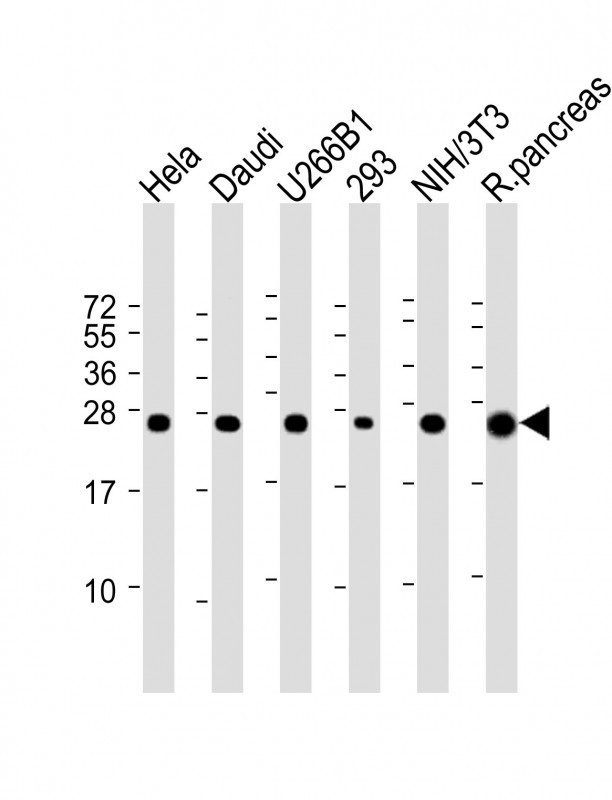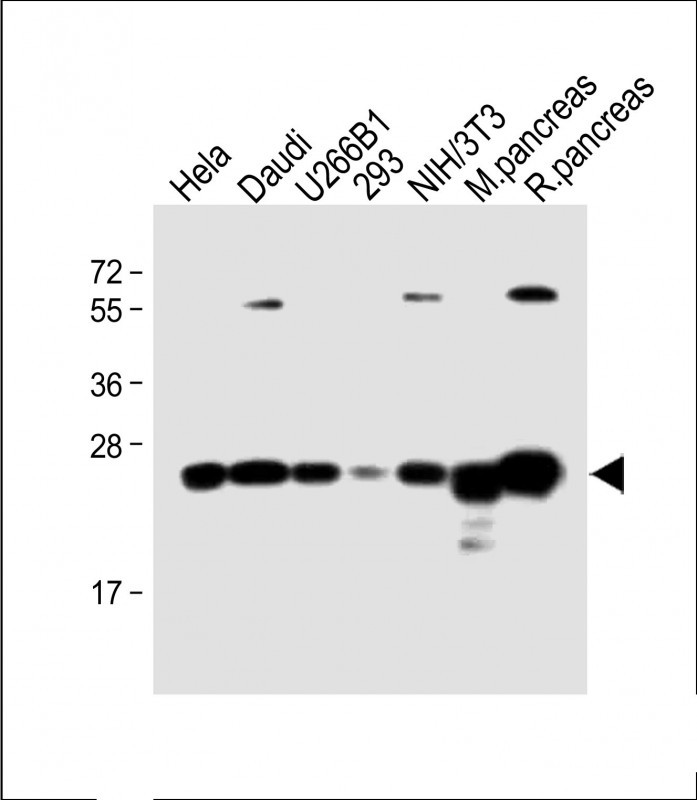RPL10 Antibody (N-term)
Affinity Purified Rabbit Polyclonal Antibody (Pab)
- SPECIFICATION
- CITATIONS: 1
- PROTOCOLS
- BACKGROUND

Application
| WB, E |
|---|---|
| Primary Accession | P27635 |
| Other Accession | Q6PDV7, Q29195, Q6ZWV3, Q4R7Y2, Q08200, Q9XSI3, P86048, Q4R4D3, Q96L21, Q2TBW8, NP_006004.2, A8D8X1, Q7ZV96, B7NZQ2 |
| Reactivity | Human, Mouse, Rat |
| Predicted | Bovine, Monkey, Chicken, Zebrafish, Pig, Rabbit, Sheep |
| Host | Rabbit |
| Clonality | Polyclonal |
| Isotype | Rabbit IgG |
| Calculated MW | 24577 Da |
| Antigen Region | 17-45 aa |
| Gene ID | 6134 |
|---|---|
| Other Names | 60S ribosomal protein L10, Laminin receptor homolog, Protein QM, Tumor suppressor QM, RPL10, DXS648E, QM |
| Target/Specificity | This RPL10 antibody is generated from rabbits immunized with a KLH conjugated synthetic peptide between 17-45 amino acids from the N-terminal region of human RPL10. |
| Dilution | WB~~1:4000 |
| Format | Purified polyclonal antibody supplied in PBS with 0.09% (W/V) sodium azide. This antibody is purified through a protein A column, followed by peptide affinity purification. |
| Storage | Maintain refrigerated at 2-8°C for up to 2 weeks. For long term storage store at -20°C in small aliquots to prevent freeze-thaw cycles. |
| Precautions | RPL10 Antibody (N-term) is for research use only and not for use in diagnostic or therapeutic procedures. |
| Name | RPL10 (HGNC:10298) |
|---|---|
| Synonyms | DXS648E, QM |
| Function | Component of the large ribosomal subunit (PubMed:26290468). Plays a role in the formation of actively translating ribosomes (PubMed:26290468). May play a role in the embryonic brain development (PubMed:25316788). |
| Cellular Location | Cytoplasm {ECO:0000250|UniProtKB:Q6ZWV3}. |

Provided below are standard protocols that you may find useful for product applications.
Background
Ribosomes, the organelles that catalyze protein synthesis, consist of a small 40S subunit and a large 60S subunit. Together these subunits are composed of 4 RNA species and approximately 80 structurally distinct proteins. This gene encodes a ribosomal protein that is a component of the 60S subunit. The protein belongs to the L10E family of ribosomal proteins. It is located in the cytoplasm. In vitro studies have shown that the chicken protein can bind to c-Jun and can repress c-Jun-mediated transcriptional activation, but these activities have not been demonstrated in vivo. This gene was initially identified as a candidate for a Wilms tumor suppressor gene, but later studies determined that this gene is not involved in the suppression of Wilms tumor. This gene has been referred to as 'laminin receptor homolog' because a chimeric transcript consisting of sequence from this gene and sequence from the laminin receptor gene was isolated; however, it is not believed that this gene encodes a laminin receptor. Transcript variants utilizing alternative polyA signals exist. The variant with the longest 3' UTR overlaps the deoxyribonuclease I-like 1 gene on the opposite strand. This gene is co-transcribed with the small nucleolar RNA gene U70, which is located in its fifth intron. As is typical for genes encoding ribosomal proteins, there are multiple processed pseudogenes of this gene dispersed through the genome.
References
Bailey, S.D., et al. Diabetes Care 33(10):2250-2253(2010)
Talmud, P.J., et al. Am. J. Hum. Genet. 85(5):628-642(2009)
Gong, X., et al. BMC Med. Genet. 10, 7 (2009) :
Nishimura, M., et al. J. Mol. Biol. 377(2):421-430(2008)
Farmer, A.A., et al. Nucleic Acids Res. 24(11):2158-2165(1996)
If you have used an Abcepta product and would like to share how it has performed, please click on the "Submit Review" button and provide the requested information. Our staff will examine and post your review and contact you if needed.
If you have any additional inquiries please email technical services at tech@abcepta.com.















 Foundational characteristics of cancer include proliferation, angiogenesis, migration, evasion of apoptosis, and cellular immortality. Find key markers for these cellular processes and antibodies to detect them.
Foundational characteristics of cancer include proliferation, angiogenesis, migration, evasion of apoptosis, and cellular immortality. Find key markers for these cellular processes and antibodies to detect them. The SUMOplot™ Analysis Program predicts and scores sumoylation sites in your protein. SUMOylation is a post-translational modification involved in various cellular processes, such as nuclear-cytosolic transport, transcriptional regulation, apoptosis, protein stability, response to stress, and progression through the cell cycle.
The SUMOplot™ Analysis Program predicts and scores sumoylation sites in your protein. SUMOylation is a post-translational modification involved in various cellular processes, such as nuclear-cytosolic transport, transcriptional regulation, apoptosis, protein stability, response to stress, and progression through the cell cycle. The Autophagy Receptor Motif Plotter predicts and scores autophagy receptor binding sites in your protein. Identifying proteins connected to this pathway is critical to understanding the role of autophagy in physiological as well as pathological processes such as development, differentiation, neurodegenerative diseases, stress, infection, and cancer.
The Autophagy Receptor Motif Plotter predicts and scores autophagy receptor binding sites in your protein. Identifying proteins connected to this pathway is critical to understanding the role of autophagy in physiological as well as pathological processes such as development, differentiation, neurodegenerative diseases, stress, infection, and cancer.


